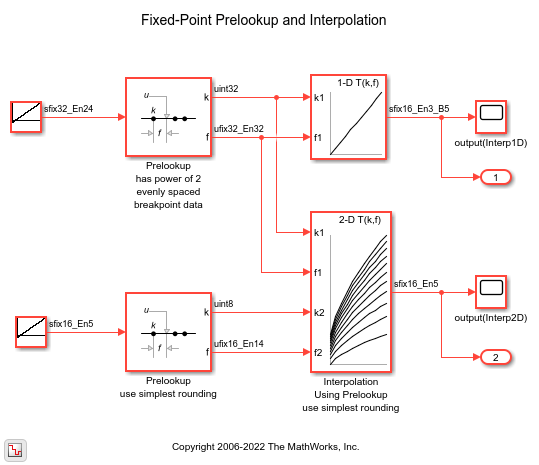Repeating Sequence Stair
输出并重复离散时间序列
库:
Simulink /
Sources
描述
Repeating Sequence Stair 模块输出并重复您使用输出值的向量参数指定的阶梯序列。例如,您可以将向量指定为 [3 1 2 4 1]'。在每个时间间隔输出输出值的向量中的值,然后重复该序列。

示例
定点 S-Function:乘积与和
此模型说明如何使用自定义的 C 语言 S-Function 来计算定点的“乘积与和”运算。要查看 S-Function 的源代码,请使用右键点击上下文菜单选择“模块参数”。当对话框出现时,按“编辑”按钮。
(Fixed-Point Designer)
Fixed-Point Prelookup and Interpolation
Demonstrates some of the features of Prelookup and Interpolation Using Prelookup blocks.
(Fixed-Point Designer)
端口
输出
根据时间值的向量和采样时间参数中的值生成的输出信号。
数据类型: single | double | int8 | int16 | int32 | int64 | uint8 | uint16 | uint32 | uint64 | Boolean | fixed point | enumerated
参数
常设
指定包含重复的阶梯序列值的向量。
编程用法
模块参数:OutValues |
| 类型:字符向量 |
| 值:向量 |
默认值:'[3 1 4 2 1].'' |
信号属性
软件检查的输出范围的下限值。
软件使用最小值执行下列操作:
某些模块的参数范围检查(请参阅指定模块参数的最小值和最大值)。
定点数据类型的自动定标。
从模型生成的代码的优化。此优化可删除算法代码,并影响某些仿真模式(如 SIL 或外部模式)的结果。有关详细信息,请参阅使用指定的最小值和值进行优化 (Embedded Coder)。
提示
输出最小值不会对实际输出信号进行饱和处理或截断。请改用 Saturation 模块。
编程用法
要以编程方式设置模块参数值,请使用 set_param 函数。
| 参数: | OutMin |
| 值: | '[]' (默认) | scalar in quotes |
软件检查的输出范围的上限值。
软件使用最大值执行下列操作:
某些模块的参数范围检查(请参阅指定模块参数的最小值和最大值)。
定点数据类型的自动定标。
从模型生成的代码的优化。此优化可删除算法代码,并影响某些仿真模式(如 SIL 或外部模式)的结果。有关详细信息,请参阅使用指定的最小值和值进行优化 (Embedded Coder)。
提示
输出最大值不会对实际输出信号进行饱和处理或截断。请改用 Saturation 模块。
编程用法
要以编程方式设置模块参数值,请使用 set_param 函数。
| 参数: | OutMax |
| 值: | '[]' (默认) | scalar in quotes |
为输出选择数据类型。该类型可以继承、直接指定或表示为数据类型对象,如 Simulink.NumericType。
数据类型助手可帮助您设置数据属性。要使用数据类型助手,请点击  。有关详细信息,请参阅使用数据类型助手指定数据类型。
。有关详细信息,请参阅使用数据类型助手指定数据类型。
编程用法
模块参数:OutDataTypeStr |
| 类型:字符向量 |
值:'Inherit: Inherit via back propagation' | 'double' | 'single' | 'int8' | 'uint8' | int16 | 'uint16' | 'int32' | 'uint32' | 'int64' | 'uint64' | fixdt(1,16,0) | fixdt(1,16,2^0,0) | fixdt(1,16,2^0,0) | '<data type expression>' |
默认值:'double' |
选中此选项将锁定此模块的输出数据类型设置,从而防止通过定点工具和定点顾问进行更改。有关详细信息,请参阅Use Lock Output Data Type Setting (Fixed-Point Designer)。
编程用法
模块参数:LockScale |
| 类型:字符向量 |
值:'off' | 'on' |
默认值:'off' |
模块特性
数据类型 |
|
直接馈通 |
|
多维信号 |
|
可变大小信号 |
|
过零检测 |
|
扩展功能
C/C++ 代码生成
使用 Simulink® Coder™ 生成 C 代码和 C++ 代码。
HDL Coder™ 提供影响 HDL 实现和综合逻辑的额外配置选项。
此模块具有一个默认 HDL 架构。
| 通用 | |
|---|---|
| ConstrainedOutputPipeline | 通过移动设计中现有延迟的方式来放置在输出端的寄存器的数量。分布式流水线不会重新分发这些寄存器。默认值为 |
| InputPipeline | 要在生成的代码中插入的输入流水线阶段数。分布式流水线和受限输出流水线可以移动这些寄存器。默认值为 |
| OutputPipeline | 要在生成的代码中插入的输出流水线阶段数。分布式流水线和受限输出流水线可以移动这些寄存器。默认值为 |
PLC 代码生成
使用 Simulink® PLC Coder™ 生成结构化文本代码。
定点转换
使用 Fixed-Point Designer™ 设计和仿真定点系统。
版本历史记录
在 R2006a 之前推出
MATLAB Command
You clicked a link that corresponds to this MATLAB command:
Run the command by entering it in the MATLAB Command Window. Web browsers do not support MATLAB commands.
选择网站
选择网站以获取翻译的可用内容,以及查看当地活动和优惠。根据您的位置,我们建议您选择:。
您也可以从以下列表中选择网站:
如何获得最佳网站性能
选择中国网站(中文或英文)以获得最佳网站性能。其他 MathWorks 国家/地区网站并未针对您所在位置的访问进行优化。
美洲
- América Latina (Español)
- Canada (English)
- United States (English)
欧洲
- Belgium (English)
- Denmark (English)
- Deutschland (Deutsch)
- España (Español)
- Finland (English)
- France (Français)
- Ireland (English)
- Italia (Italiano)
- Luxembourg (English)
- Netherlands (English)
- Norway (English)
- Österreich (Deutsch)
- Portugal (English)
- Sweden (English)
- Switzerland
- United Kingdom (English)

